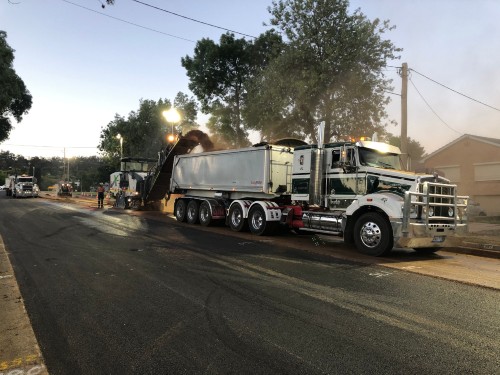
Council regularly posts roadwork updates on its Facebook page. But what exactly do the different roadwork types mean? Jamie Harwood, Council's Engineer – Maintenance Management, explains.
Resurfacing / reseal works is a non-structural aggregate seal treatment to the wearing course (the surface layer), which improves skid resistance, protects the lower granular pavement from water infiltration and preserves pavement life.
A pavement wearing course will generally require maintenance anywhere from 10–15 years, depending on the initial treatment. Pavement structural life can, however, range from 20–30 years, so maintaining the wearing course is critical to ensure the pavement reaches its desired lifecycle.
Reseal works are a planned maintenance activity Council carries out across the local government area. We generally anticipate resealing between 30–40 km each financial year.
Prior to resealing the road, preparation works are sometimes required to remove isolated structurally damaged sections within the pavement layers. 'Crocodile cracking' is a common distress mode and looks like crocodile skin.
Preparation works can also include minor drainage improvements, along with kerb and gutter replacement where needed. Reseal treatments will slow down the rate of deterioration to the pavement and are an excellent preventative maintenance strategy.
Asphalt works can also be a resurfacing treatment or a structural improvement to the pavement in the form of an overlay on an existing pavement, deep lift, or full-strength asphalt pavement.
For example, the recent Lake Albert Road project involved full-depth asphalt. In this instance, we used asphalt due to the urban environment and the hierarchy of the road corridor.
Using asphalt sped up the construction works and caused minimal disruption to the community. The strength characteristics of asphalt means the pavement thickness can also be reduced, minimising excavation and reducing the risk of disturbing existing services within the road carriageway which can be at minimum depth in some areas.
Asphalt is superior in quality and strength compared to a sprayed seal treatment and the community will notice its smooth ride quality. However, asphalt is also considerably more expensive, and it is not economically feasible to use this as a maintenance treatment in all road segments. Consequently, Council generally only uses asphalt in high traffic or high-stress areas.
Sprayed seal treatments are still very robust and make up for approximately 90 per cent of Australia's sealed road network, making it economically practical as a maintenance reseal treatment compared to asphalt.
Road rehabilitation is carried out to improve, strengthen or salvage existing deficiencies within the pavement. This allows the road to continue to service the community for an extended period with only minimal traffic distribution compared to full-depth reconstruction.
We rehabilitate roads when the pavement structure has reached its anticipated design life and a reseal treatment would be insufficient. The process requires the existing material to be either removed or replaced to improve strength characteristics.
Rehabilitation is different to road reconstruction projects, in that rehabilitation takes place when the existing road materials can be salvaged and modified or improved in situ.
We generally anticipate rehabilitating between 13–15 km each financial year.
Road reconstruction is generally full-depth replacement, where we import new pavement material and improve the subgrade (foundations or platform that the pavement structure will sit on).
If you have a request regarding a road issue, visit wagga.nsw.gov.au/servicerequests or call 1300 292 442.






